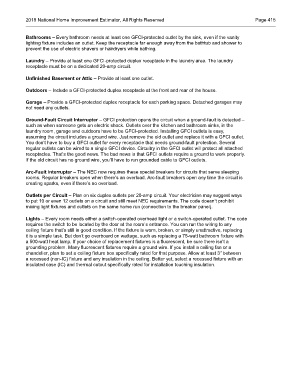Page 521 - 2018 National Home Improvement
P. 521
2018 National Home Improvement Estimator, All Rights Reserved Page 415
Bathrooms – Every bathroom needs at least one GFCI-protected outlet by the sink, even if the vanity
lighting fixture includes an outlet. Keep the receptacle far enough away from the bathtub and shower to
prevent the use of electric shavers or hairdryers while bathing.
Laundry – Provide at least one GFCI-protected duplex receptacle in the laundry area. The laundry
receptacle must be on a dedicated 20-amp circuit.
Unfinished Basement or Attic – Provide at least one outlet.
Outdoors – Include a GFCI-protected duplex receptacle at the front and rear of the house.
Garage – Provide a GFCI-protected duplex receptacle for each parking space. Detached garages may
not need any outlets.
Ground-Fault Circuit Interrupter – GFCI protection opens the circuit when a ground-fault is detected –
such as when someone gets an electric shock. Outlets over the kitchen and bathroom sinks, in the
laundry room, garage and outdoors have to be GFCI-protected. Installing GFCI outlets is easy,
assuming the circuit includes a ground wire. Just remove the old outlet and replace it with a GFCI outlet.
You don’t have to buy a GFCI outlet for every receptacle that needs ground-fault protection. Several
regular outlets can be wired to a single GFCI device. Circuitry in the GFCI outlet will protect all attached
receptacles. That’s the good news. The bad news is that GFCI outlets require a ground to work properly.
If the old circuit has no ground wire, you’ll have to run grounded cable to GFCI outlets.
Arc-Fault Interrupter – The NEC now requires these special breakers for circuits that serve sleeping
rooms. Regular breakers open when there’s an overload. Arc-fault breakers open any time the circuit is
creating sparks, even if there’s no overload.
Outlets per Circuit – Plan on six duplex outlets per 20-amp circuit. Your electrician may suggest ways
to put 10 or even 12 outlets on a circuit and still meet NEC requirements. The code doesn’t prohibit
mixing light fixtures and outlets on the same home run (connection to the breaker panel).
Lights – Every room needs either a switch-operated overhead light or a switch-operated outlet. The code
requires the switch to be located by the door at the room’s entrance. You can run the wiring to any
ceiling fixture that’s still in good condition. If the fixture is worn, broken, or simply unattractive, replacing
it is a simple task. But don’t go overboard on wattage, such as replacing a 75-watt bathroom fixture with
a 500-watt heat lamp. If your choice of replacement fixtures is a fluorescent, be sure there isn’t a
grounding problem. Many fluorescent fixtures require a ground wire. If you install a ceiling fan or a
chandelier, plan to set a ceiling fixture box specifically rated for that purpose. Allow at least 3" between
a recessed (non-IC) fixture and any insulation in the ceiling. Better yet, select a recessed fixture with an
insulated case (IC) and thermal cutout specifically rated for installation touching insulation.

